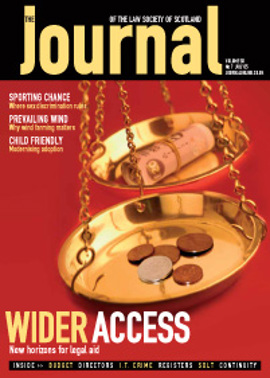A Wie hint of change?

This month, 156 golfers teed off in pursuit of the Open Championship. The entrants will almost certainly all have been men, but earlier this year the R and A announced that from next year women will be permitted to enter. A major factor behind this decision has been the emergence of the 15 year old American sensation, Michelle Wie who has been described by Tiger Woods as the most talented golfing prospect, male or female, in the world today.
From a legal point of view the interesting thing is that the R and A has been able to decide when and how the entry rules should be changed. This is because section 44 of the Sex Discrimination Act 1975 has provided it with the legal basis to keep women out. The purpose of this short article is to explain the current state of the law and to consider justifications for single-sex competitions. It should be pointed out that this is a complex topic and space permits no more than an introduction to the subject.
Free to exclude
Section 44 provides: “Nothing in Parts II to IV [which concern discrimination in various fields] shall in relation to any sport, game or activity of a competitive nature where the physical strength, stamina or physique of the average woman puts her at a disadvantage to the average man, render unlawful any act related to the participation of a person as a competitor in events involving that activity which are confined to competitors of one sex.”
As interpreted by the courts, the section is an extremely wide exception to the anti-discrimination principles of the Act. In Bennet v The Football Association, CA, 1978, unreported, an 11 year old girl was prevented from playing for a boys’ team (which wanted her to play) by the governing body, which had a rule prohibiting mixed teams. All three judges agreed that the strength and skill of the applicant were irrelevant. They also decided that section 44 required a comparison between the strength, stamina and physique of the average adult man and woman, not a comparison between persons of the age of the applicant. Thus, evidence indicating that there is no difference in the strength, etc of girls and boys aged 11 was irrelevant. In his judgment, Lord Denning said: “it seems to me that football is a game which is excepted from this statute. It is a game [in] which on all the evidence here the average woman is at a disadvantage to the average man because she has not got the stamina or physique to stand up to men in regard to it” (quoted in Pannick, Sex Discrimination in Sport, Equal Opportunities Commission, 1983).
In Petty v British Judo Association [1981] ICR 660, it was held that the section applies only to participants and does not extend to referees. Consequently, the applicant had been unlawfully discriminated against in being prevented from refereeing men’s judo. In Couch v The British Boxing Board of Control, 1997, unreported, it was held that the section only applies to mixed competitions. It could not be used to deny a female boxer a licence to fight other female boxers.
Although both Petty and Couch won their cases, it is submitted that the decisions have done very little to reduce the impact of section 44 as they are not concerned with participation in mixed-sex sport. Bennet is the key case. It demonstrates the width of the section. It seems that all but the least physically demanding of sports events can lawfully be restricted to members of one sex. It should be noted that this works both ways and therefore allows women-only events, but only where strength, stamina or physique are advantages. Thus, it may be unlawful to prohibit a man from entering a women’s bowls or darts event – unless it can be brought within one of the other exceptions in the Act.
A way to challenge?
Where section 44 applies, an athlete who wishes to compete with or against the opposite sex can do so if the rules of the competition permit it. If the rules do not permit it, are there any grounds for challenge? The Human Rights Act 1998 appears to offer little comfort as none of the rights specified in the Convention are likely to be interpreted as applying to participation in sport. In Whaley v Lord Advocate 2004 SC 78 it was held that the freedom of expression protected by article 10 does not extend to the carrying on of activities such as foxhunting. It is also unlikely that single-sex sports could be challenged using the article 11 right to freedom of association.
It is possible that EU law may provide an avenue for challenge, at least for professional sports people. It is well established that EU law applies to sport insofar as it amounts to an economic activity, and that professional sport is an economic activity: Walrave and Koch v Association Union Cycliste Internationale [1974] ECR 1405. This opens up the possibility of claims under article 39 (free movement of workers) or article 49 (freedom to provide services) among others. However, it is equally clear that the European Court of Justice will not interfere with rules which are of sporting interest only, provided that they are limited to their proper objective (most recently discussed in Meca-Medina v Commission [2004] 3 CMLR 60). The debate would then centre on whether there are legitimate sporting reasons for limiting competitions to members of one sex. The remainder of this article will therefore consider some of the main arguments for single-sex as opposed to mixed competitions.
Why single-sex competitions?
Proponents of single-sex sports usually make some or all of the following arguments: there is a gap in performance in most sports between men and women – having separate events enables them to compete on a level playing field; there is little point in allowing women to enter men’s events because they would not be able to compete successfully; if top female athletes move into men’s sport, the women’s events will be bereft of their most marketable assets; a relaxation of the law would have to cut both ways – this would lead to mediocre males dominating female sport. Contact sports present additional problems: differences in strength and physique create an unacceptable risk of injury to women; this would lead to a fundamental alteration in the nature of contact sports which have been a central part of our culture for hundreds of years; there might also be a risk of sexual assaults. For these, and other reasons, sports governing bodies should not be legally obliged to provide mixed sports events.
Reasons to mix
The case for mixed competition is that sport is one of the last bastions of sexism in society. Denying women access to men’s sport is contrary to the ethos of the Act that, where it applies, people should be treated by reference to their strengths and weaknesses as individuals. The separation of males and females in sport contributes to exaggerated notions of innate differences between the sexes and the physical weakness of women (J Hargreaves, Sporting Females: Critical Issues in the History and Sociology of Women’s Sport, Routledge, 2004). Athletes such as Michelle Wie, Paula Radcliffe, Ellen McArthur and Carrie Ford have recently challenged the assumption that women cannot compete against men in sport. In any event it should not be assumed that women would only want to compete with or against men if they could excel. There may not, at the moment, be any female footballers who are good enough to play in the Premiership, but undoubtedly there would be a level of men’s football at which they could play. Why should they be prevented from doing so solely because of their sex?
It is doubtful that women’s sport would suffer, it is also said, because the top athletes would cross over to the men’s game. Indeed the opposite is likely – girls may well become inspired to take up sport if they see female role models challenging the assumption that men are better at sport. The safety argument is discriminatory. Contact sports carry a risk of injury and all participants accept that risk. Not all women are smaller and weaker than all men. Smaller and weaker men are not prevented from playing contact sports because they have a greater risk of injury, as long as they are good enough to be selected. Why should women be treated any differently? Another point to note is that up until the age of about 12 there is no difference in the average size of girls and boys (cf Taylor v Moorabbin Saints Junior Football League [2004] Victoria Civil and Administrative Tribunal 158). Governing bodies cannot be left to decide because they are male-dominated organisations.
Would it work both ways?
The above points do not deal with the question of men competing in women’s events. It does not, however, follow that a relaxation of section 44 would have to work both ways. One reason for this, it has been argued, is that the development of women’s sport has historically been controlled by men (Hargreaves, Sporting Females, above). A good example is football in England, which flourished during and after the First World War to such an extent that in 1920 a women’s match attracted a crowd of 53,000. Shortly afterwards, the FA decreed that football was unsuitable for women and members were banned from allowing women to use their facilities. This contributed significantly to the demise of the women’s game (J Williams, A Game for Rough Girls: The History of Women’s Football in Britain, Routledge, 2003). This is not an isolated example and the historic control of sport by men can be used as one justification for keeping men out of women’s sport whilst allowing women into men’s sport. (It should be noted that an added complication in this area is the right of transsexuals to play sport in their acquired gender: see section 19 of the Gender Recognition Act 2004 and S Cornelius, “Affirmation of (in)equality”, ISLJ 2004 3/4, 72-75.)
Whilst talented golfers like Michelle Wie may in future be able to compete in the British Open, it seems that women who are denied the opportunity to compete against men will continue to face major legal hurdles.
James McDougall, Lecturer in Law, Napier University
In this issue
- Commissioner: Public Authorities must do more
- Supporting legal aid
- No country cousins
- Making the money go further
- Adopting a new approach
- Gordon giveth and Gordon taketh away
- A blow for the future
- A Wie hint of change?
- Raising the bar
- The IT crimewave
- The directing mind
- Going through the motions
- Planning in the park
- Always look on the bright side
- Scottish Solicitors' Discipline Tribunal
- Website reviews
- Book reviews
- The race to the registers revisited
- SDLT: getting it right
- SDLT: barcoding
- Business sense






